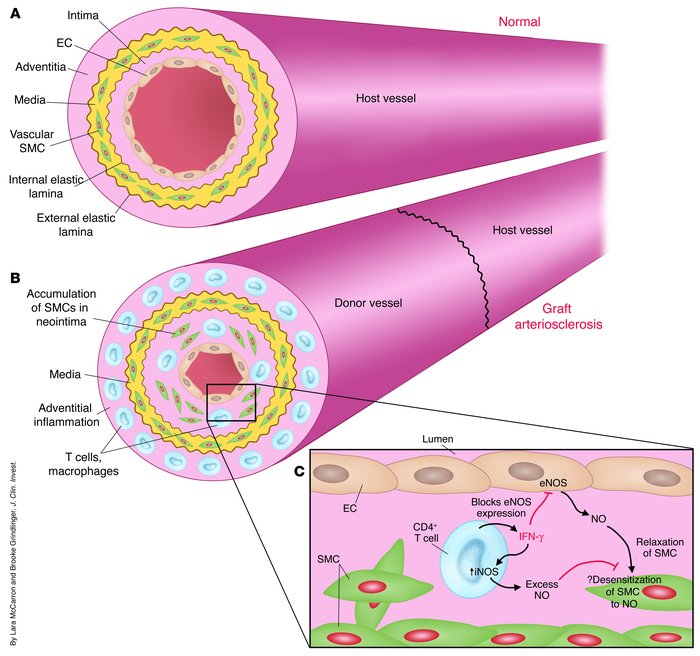Richard N. Mitchell, Andrew H. Lichtman
Citation Information: J Clin Invest. 2004;114(6):762-764. https://doi.org/10.1172/JCI22927.
Richard N. Mitchell, Andrew H. Lichtman
Published September 15, 2004
Citation Information: J Clin Invest. 2004;114(6):762-764. https://doi.org/10.1172/JCI22927.
Abstract
Vascularized organ transplants often fail because of smooth muscle cell migration and proliferation in the intima of graft arteries, leading to progressive lumenal narrowing and resultant ischemic damage. Graft arterial disease is caused by IFN-γ secreted by alloreactive T cells. New evidence indicates that IFN-γ dysregulates expression of the enzymes eNOS and iNOS in graft-infiltrating leukocytes. Dysregulated NO synthase expression occurs prior to and is causally linked to intimal smooth muscle cell accumulation.
Authors
Richard N. Mitchell, Andrew H. Lichtman
Figure 1
Options:
View larger image
(or click on image)
Download as PowerPoint
Pathology and mechanisms of graft arterial disease. (A ) A cross section of a normal muscular artery is shown. The thin intima includes the endothelial lining of the lumen and minimal subendothelial connective tissue. The media is demarcated by internal and external elastic lamina and includes vascular SMCs. The adventitia is a loose connective tissue sheath outside the media. There are few or no inflammatory cells in any of the layers. (B ) In graft arteriosclerosis, inflammatory cells, including T cells and macrophages, infiltrate both the adventitia and the intima. Furthermore, SMCs derived from either the media or circulating host progenitors enter the intima and proliferate. This results in thickening of the lumen and eventual luminal narrowing. (C ) A proposed mechanism of intimal SMC proliferation is shown, based on recent data from the Pober laboratory (12 ). IFN-γ is produced by alloreactive T cells within graft arterial walls. The IFN-γ blocks the expression of eNOS and enhances the expression of iNOS by the T cells themselves. Excess NO produced by the T cells may desensitize SMCs to the relaxation and antiproliferative effects of NO. Neutralization of IFN-γ blocks changes in eNOS and iNOS expression induced by alloreactve T cells, and a pharmacologic inhibitor of iNOS partially blocks development of intimal SMC accumulation.



Copyright © 2025 American Society for Clinical Investigation
ISSN: 0021-9738 (print), 1558-8238 (online)

